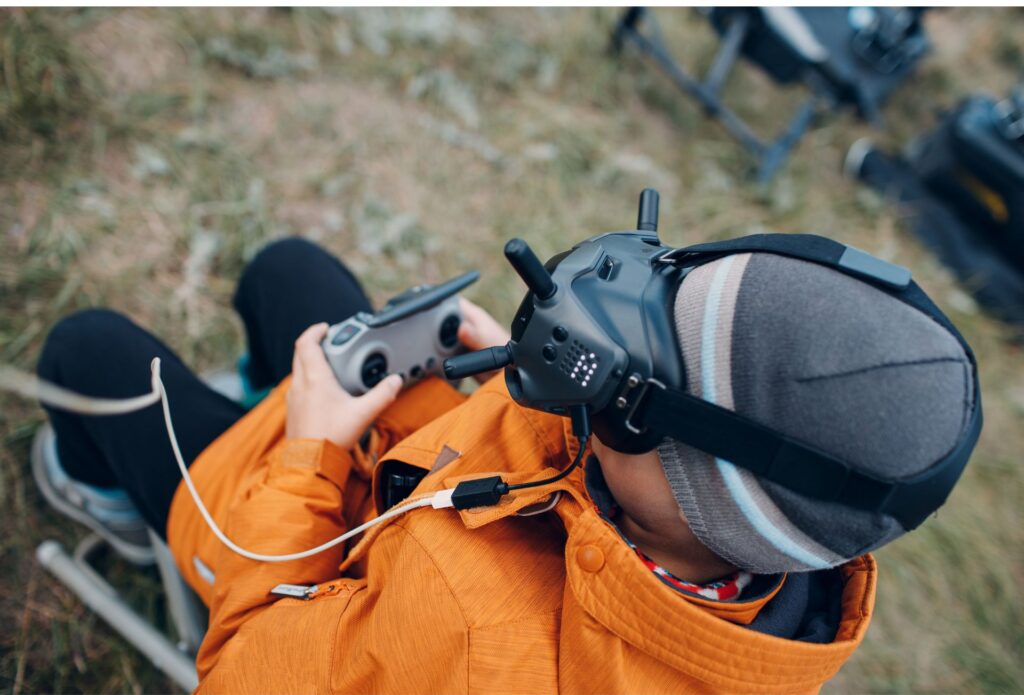FPV stands for “First Person View,” and it refers to a method used in various remote-controlled vehicles, such as drones, cars, or planes, where a live video feed from an onboard camera is transmitted to a display or headset worn by the operator. The operator then experiences the perspective of being inside the vehicle, as if they are piloting or driving it from a first-person viewpoint.
In the context of drones, FPV flying involves using a combination of specialised equipment:
- FPV Camera: A small, lightweight camera mounted on the drone that captures real-time video footage.
- Video Transmitter: The transmitter sends the live video feed from the camera to the ground.
- FPV Goggles or Display: The operator wears FPV goggles or uses a screen to view the live video feed from the drone, providing an immersive first-person perspective.
- Remote Control (RC) Transmitter: The operator uses a standard RC transmitter to control the drone’s movement.
FPV is widely used in various hobbies and industries, including drone racing, cinematography, search and rescue operations, and recreational flying. It adds a level of immersion and precision to remote-controlled activities, allowing operators to navigate and control their vehicles with a more direct and intuitive experience. FPV technology has become increasingly popular, and there are dedicated communities, events, and equipment designed specifically for FPV enthusiasts.
WHY FPV IS IMPORTANT?
FPV (First Person View) technology, including FPV flying with drones, can be important in India for several reasons:
- Recreational Enjoyment:
- FPV flying offers an immersive and exciting experience for recreational users. It allows enthusiasts to explore their surroundings from a unique perspective, capturing breathtaking aerial views and enjoying the thrill of piloting a drone in first-person view.
- Drone Racing and Competitions:
- FPV technology has given rise to drone racing, a competitive sport where pilots navigate drones through courses at high speeds. FPV racing events and competitions provide a platform for enthusiasts to showcase their skills, compete, and build a community around the sport.
- Agricultural Applications:
- Drones equipped with FPV systems can be used in agriculture for crop monitoring, pest control, and assessing the health of crops. FPV allows farmers to get a real-time view of their fields, enabling more efficient and targeted interventions.
- Search and Rescue Operations:
- FPV-enabled drones can be valuable tools in search and rescue missions. The live video feed allows operators to navigate through challenging terrains and provide a real-time view of the search area, aiding in locating missing persons or assessing disaster-stricken areas.
- Surveying and Mapping:
- FPV technology is useful for surveying and mapping applications. Drones equipped with FPV systems can capture high-resolution images and videos, aiding in land surveying, construction site monitoring, and infrastructure inspection.
- Filmmaking and Photography:
- FPV drones are increasingly used in the film and photography industry to capture dynamic and cinematic shots. The ability to fly and control the drone from a first-person perspective allows filmmakers and photographers to achieve creative and unique angles.
- Educational and Training Purposes:
- FPV technology can be used in educational settings to teach students about drone technology, aerodynamics, and remote piloting. It provides a hands-on and engaging way for individuals to learn about aviation and robotics.
- Technological Advancements:
- Keeping up with FPV technology allows individuals in India to stay connected with global advancements in the drone and remote-controlled vehicle space. This can lead to local innovation, skill development, and the potential for new applications.
While enjoying the benefits of FPV technology, it’s crucial for users in India to adhere to local regulations and guidelines set by aviation authorities to ensure safe and responsible drone use. Compliance with rules helps mitigate risks and contributes to the sustainable growth of the FPV community.

